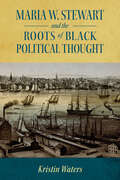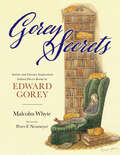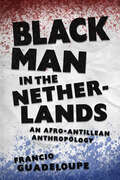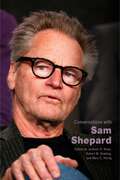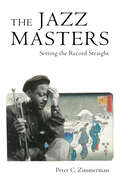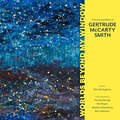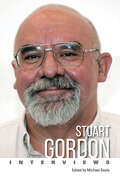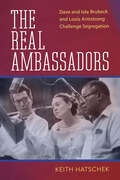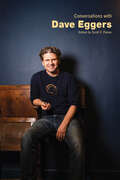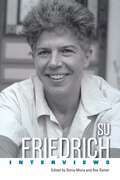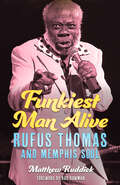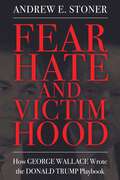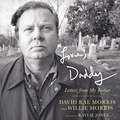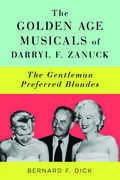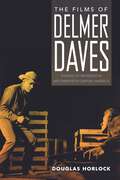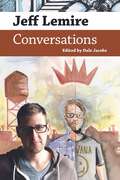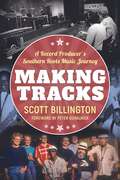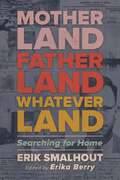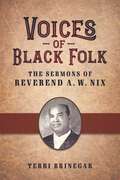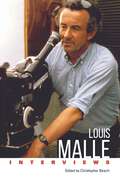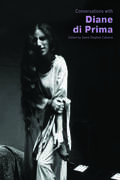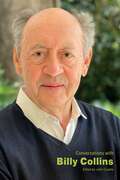- Table View
- List View
Maria W. Stewart and the Roots of Black Political Thought (Margaret Walker Alexander Series in African American Studies)
by Kristin WatersNamed a 2022 finalist for the Pauli Murray Book Prize in Black Intellectual History from the African American Intellectual History SocietyMaria W. Stewart and the Roots of Black Political Thought tells a crucial, almost-forgotten story of African Americans of early nineteenth-century America. In 1833, Maria W. Stewart (1803–1879) told a gathering at the African Masonic Hall on Boston’s Beacon Hill: “African rights and liberty is a subject that ought to fire the breast of every free man of color in these United States.” She exhorted her audience to embrace the idea that the founding principles of the nation must extend to people of color. Otherwise, those truths are merely the hypocritical expression of an ungodly white power, a travesty of original democratic ideals. Like her mentor, David Walker, Stewart illustrated the practical inconsistencies of classical liberalism as enacted in the US and delivered a call to action for ending racism and addressing gender discrimination. Between 1831 and 1833, Stewart’s intellectual productions, as she called them, ranged across topics from true emancipation for African Americans, the Black convention movement, the hypocrisy of white Christianity, Black liberation theology, and gender inequity. Along with Walker’s Appeal to the Coloured Citizens of the World, her body of work constitutes a significant foundation for a moral and political theory that is finding new resonance today—insurrectionist ethics.In this work of recovery, author Kristin Waters examines the roots of Black political activism in the petition movement; Prince Hall and the creation of the first Black masonic lodges; the Black Baptist movement spearheaded by the brothers Thomas, Benjamin, and Nathaniel Paul; writings; sermons; and the practices of festival days, through the story of this remarkable but largely unheralded woman and pioneering public intellectual.
Gorey Secrets: Artistic and Literary Inspirations behind Divers Books by Edward Gorey
by Malcolm WhyteEdward Gorey (1925–2000) was a fascinating and prolific author and artist. Of the one hundred delightful and fascinating books that Gorey wrote and illustrated, he rarely revealed their specific inspirations or their meanings. Where did his intriguing ideas come from? In Gorey Secrets: Artistic and Literary Inspirations behind Divers Books by Edward Gorey, Malcolm Whyte utilizes years of thorough research to tell an engrossing, revealing story about Gorey’s unique works. Exploring a sampling of Gorey’s eclectic writings, from The Beastly Baby and The Iron Tonic to The Curious Sofa and Dracula, Whyte uncovers influences of Herman Melville, Agatha Christie, Edward Lear, the I Ching, William Hogarth, Rene Magritte, Hokusai, French cinema, early toy books, eighteenth-century religious tracts for children, and much more.With an enlightening preface by Gorey collaborator and scholar Peter F. Neumeyer, Gorey Secrets brings important, uncharted insight into the genius of Edward Gorey and is a welcome addition to collections of both the seasoned Gorey reader and those who are just discovering his captivating books.
Black Man in the Netherlands: An Afro-Antillean Anthropology
by Francio GuadeloupeFrancio Guadeloupe has lived in both the Dutch Antilles and the Netherlands. An anthropologist by vocation, he is a keen observer by honed habit. In his new book, he wields both personal and anthropological observations. Simultaneously memoir and astute exploration, Black Man in the Netherlands charts Guadeloupe’s coming of age and adulthood in a Dutch world and movingly makes a global contribution to the understanding of anti-Black racism. Guadeloupe identifies the intersections among urban popular culture, racism, and multiculturalism in youth culture in the Netherlands and the wider Dutch Kingdom. He probes the degrees to which traditional ethnic division collapses before a rising Dutch polyethnicity. What comes to light, given the ethnic multiplicity that Afro-Antilleans live, is their extraordinarily successful work in forging an anti-racist Dutch identity via urban popular culture. This alternative way of being Dutch welcomes the Black experience as global and increasingly local Black artists find fame and even idolization. Black Man in the Netherlands is a vivid extension of renowned critical race studies by such Marxist theorists as Achille Mbembe, Paul Gilroy, Stuart Hall, and C. L. R. James, and it bears a palpable connection to such Black Atlantic artists as Peter Tosh, Juan Luis Guerra, and KRS-One. Guadeloupe explores the complexities of Black life in the Netherlands and shows that within their means, Afro-Antilleans often effectively contest Dutch racism in civic and work life.
Conversations with Sam Shepard (Literary Conversations Series)
by Jackson R. Bryer, Robert M. Dowling, and Mary C. HartigA prolific playwright, Sam Shepard (1943–2017) wrote fifty-six produced plays, for which he won many awards, including a Pulitzer Prize. He was also a compelling, Oscar-nominated film actor, appearing in scores of films. Shepard also published eight books of prose and poetry and was a director (directing the premiere productions of ten of his plays as well as two films); a musician (a drummer in three rock bands); a horseman; and a plain-spoken intellectual. The famously private Shepard gave a significant number of interviews over the course of his public life, and the interviewers who respected his boundaries found him to be generous with his time and forthcoming on a wide range of topics. The selected interviews in Conversations with Sam Shepard begin in 1969 when Shepard, already a multiple Obie winner, was twenty-six and end in 2016, eighteen months before his death from complications of ALS at age seventy-three. In the interim, the voice, the writer, and the man evolved, but there are themes that echo throughout these conversations: the indelibility of family; his respect for stage acting versus what he saw as far easier film acting; and the importance of music to his work. He also speaks candidly of his youth in California, his early days as a playwright in New York City, his professionally formative time in London, his interests and influences, the mythology of the American Dream, his own plays, and more. In Conversations with Sam Shepard, the playwright reveals himself in his own words.
The Jazz Masters: Setting the Record Straight (American Made Music Series)
by Peter C. ZimmermanThe Jazz Masters: Setting the Record Straight is a celebration of jazz and the men and women who created and transformed it. In the twenty-one conversations contained in this engaging and highly accessible book, we hear from the musicians themselves, in their own words, direct and unfiltered. Peter Zimmerman’s interviewing technique is straightforward. He turns on a recording device, poses questions, and allows his subjects to improvise, similar to the way the musicians do at concerts and in recording sessions. Topics range from their early days, their struggles and victories, to the impact the music has had on their own lives. The interviews have been carefully edited for sense and clarity, without changing any of the musicians’ actual words.Peter Zimmerman tirelessly sought virtuosi whose lives span the twentieth and twenty-first centuries. The reader is rewarded with an intimate look into the past century’s extraordinary period of creative productivity. The oldest two interview subjects were born in 1920 and all are professional musicians who worked in jazz for at least five decades, with a few enjoying careers as long as seventy-five years. These voices reflect some seventeen hundred years of accumulated experience yielding a chronicle of incredible depth and scope.The focus on musicians who are now emeritus figures is deliberate. Some of them are now in their nineties; six have passed since 2012, when Zimmerman began researching The Jazz Masters. Five of them have already received the NEA’s prestigious Jazz Masters award: Sonny Rollins, Clark Terry, Yusef Lateef, Jimmy Owens, and most recently, Dick Hyman. More undoubtedly will one day, and the balance are likewise of compelling interest. Artists such as David Amram, Charles Davis, Clifford Jordan, Valery Ponomarev, and Sandy Stewart, to name a few, open their hearts and memories and reveal who they are as people.This book is a labor of love celebrating the vibrant style of music that Dizzy Gillespie once described as “our native art form.” Zimmerman’s deeply knowledgeable, unabashed passion for jazz brings out the best in the musicians. Filled with personal recollections and detailed accounts of their careers and everyday lives, this highly readable, lively work succeeds in capturing their stories for present and future generations. An important addition to the literature of music, The Jazz Masters goes a long way toward “setting the record straight.”
Worlds beyond My Window: The Life and Work of Gertrude McCarty Smith
by Thomas R. Brooks Pat Pinson Stephen Rosenberg Rick WilemonArtist, columnist, and poet Gertrude McCarty Smith (1923–2007) of Collins, Mississippi, carried herself as a demure and proper southern lady, yet this was deceiving as she was a prolific, creative trailblazer who had collectors and dedicated readers from coast to coast, and even in Europe. She grew up during the Great Depression with only some vivid storytelling and pictures from the family Bible to inspire and kindle her artistic spirit. However, at the age of ten, her career launched when her grandmother coaxed her with a box of crayons to milk the family cow—her seventy-year love affair with the arts was born. Over the years, she would express her creativity in many forms, resulting in thousands of paintings, sculptures, songs, poems, and newspaper columns and along the way a variety of artful cakes, as she ran a celebrated twenty-five-year cake business. Her art appeared in all shapes, sizes, materials, and “eatability.” For most of her early career, Gertrude dabbled with a variety of styles—with subjects mostly centered around life in rural Mississippi and her spiritual life. But in 1980 at the age of fifty-seven, she attended her first Mississippi Art Colony at Camp Jacob in Utica, Mississippi. Over the next fifteen years, she would make her pilgrimage twice a year to be inspired by celebrated guest instructors from around the nation and connect with fellow artists. The Colony was a major catalyst, exposing her to new styles, giving her encouragement and freedom to experiment. Gertrude said of the Colony, “I never knew anything about abstract art, but it fascinated me to no end. Abstract art to me is like a beautiful melody without words. In mixed media, I am in another world and often am surprised at the piece that evolves from the torn watercolor papers. The effect is a kaleidoscope of colors that makes the retinas dance.” This book features more than 150 images; a dozen poems; insightful essays from New York art dealer Stephen Rosenberg, acclaimed southern cultural scholar and curator Pat Pinson, and artist, curator, and instructor Rick Wilemon; along with a foreword by Tommy King, president of William Carey University; and a chronicle of her life’s journey by her son-in-law, Thomas R. Brooks. As Rosenberg has said, “Gertrude Smith is a remarkable and authentic American woman who teaches us that talent and creativity combined with a humanistic spirit is both a state of mind and a state of grace—at any age.” Book proceeds will benefit the Gertrude McCarty Smith Foundation for the Arts to bring access and passion for literature, performance, and visual arts to children in underserved communities throughout Mississippi.
Stuart Gordon: Interviews (Conversations with Filmmakers Series)
by Michael DoyleAnimated by a singularly subversive spirit, the fiendishly intelligent works of Stuart Gordon (1947–2020) are distinguished by their arrant boldness and scab-picking wit. Provocative gems such as Re-Animator, From Beyond, Dolls, The Pit and the Pendulum, and Dagon consolidated his fearsome reputation as one of the masters of the contemporary horror film, bringing an unfamiliar archness, political complexity, and critical respect to a genre so often bereft of these virtues. A versatile filmmaker, one who resolutely refused to mellow with age, Gordon proved equally adept at crafting pointed science fiction (Robot Jox, Fortress, Space Truckers), sweet-tempered fantasy (The Wonderful Ice Cream Suit), and nihilistic thrillers (King of the Ants, Edmond, Stuck), customarily scrubbing the sharply drawn lines between exploitation and arthouse cinema.The first collection of interviews ever to be published on the director, Stuart Gordon: Interviews contains thirty-six articles spanning a period of fifty years. Bountiful in anecdote and information, these candid conversations chronicle the trajectory of a fascinating career—one that courted controversy from its very beginning. Among the topics Gordon discusses are his youth and early influences, his founding of Chicago’s legendary Organic Theatre (where he collaborated with such luminaries as Ray Bradbury, Kurt Vonnegut, and David Mamet), and his transition into filmmaking where he created a body of work that injected fresh blood into several ailing staples of American cinema. He also reveals details of his working methods, his steadfast relationships with frequent collaborators, his great love for the works of Lovecraft and Poe, and how horror stories can masquerade as sociopolitical commentaries.
The Real Ambassadors: Dave and Iola Brubeck and Louis Armstrong Challenge Segregation (American Made Music Series)
by Keith HatschekWinner of the 2023 ASCAP Foundation Deems Taylor/Virgil Thomson Book AwardRecipient of a 2023 Certificate of Merit for Best Historical Research in Recorded Jazz from the Association for Recorded Sound CollectionsKeith Hatschek tells the story of three determined artists: Louis Armstrong, Dave Brubeck, and Iola Brubeck and the stand they took against segregation by writing and performing a jazz musical titled The Real Ambassadors. First conceived by the Brubecks in 1956, the musical’s journey to the stage for its 1962 premiere tracks extraordinary twists and turns across the backdrop of the civil rights movement. A variety of colorful characters, from Broadway impresarios to gang-connected managers, surface in the compelling storyline. During the Cold War, the US State Department enlisted some of America’s greatest musicians to serve as jazz ambassadors, touring the world to trumpet a so-called “free society.” Honored as celebrities abroad, the jazz ambassadors, who were overwhelmingly African Americans, returned home to racial discrimination and deferred dreams. The Brubecks used this double standard as the central message for the musical, deploying humor and pathos to share perspectives on American values. On September 23, 1962, The Real Ambassadors’s stunning debut moved a packed arena at the Monterey Jazz Festival to laughter, joy, and tears. Although critics unanimously hailed the performance, it sadly became a footnote in cast members’ bios. The enormous cost of reassembling the star-studded cast made the creation impossible to stage and tour. However, The Real Ambassadors: Dave and Iola Brubeck and Louis Armstrong Challenge Segregation caps this jazz story by detailing how the show was triumphantly revived in 2013 by the Detroit Jazz Festival and in 2014 by Jazz at Lincoln Center. This reaffirmed the musical’s place as an integral part of America’s jazz history and served as an important reminder of how artists’ voices are a powerful force for social change.
Conversations with Dave Eggers (Literary Conversations Series)
by Scott F. ParkerIt’s been barely twenty years since Dave Eggers (b. 1970) burst onto the American literary scene with the publication of his memoir, A Heartbreaking Work of Staggering Genius. In that time, he has gone on to publish several books of fiction, a few more books of nonfiction, a dozen books for children, and many harder-to-classify works. In addition to his authorship, Eggers has established himself as an influential publisher, editor, and designer. He has also founded a publishing company, McSweeney’s; two magazines, Might and McSweeney’s Quarterly Concern; and several nonprofit organizations. This whirlwind of productivity, within publishing and beyond, gives Eggers a unique standing among American writers: jack of all trades, master of same.The interviews contained in Conversations with Dave Eggers suggest the range of Eggers’s pursuits—a range that is reflected in the variety of the interviews themselves. In addition to the expected interviews with major publications, Eggers engages here with obscure magazines and blogs, trade publications, international publications, student publications, and children from a mentoring program run by one of his nonprofits. To read the interviews in sequence is to witness Eggers’s rapid evolution. The cultural hysteria around Eggers’s memoir and his complicated relationship with celebrity are clear in many of the earlier interviews. From there, as the buzz around him mellows, Eggers responds in kind, allowing writing and his other endeavors to come to the fore of his conversations. Together, these interviews provide valuable insight into a driving force in contemporary American literature.
Su Friedrich: Interviews (Conversations with Filmmakers Series)
by Sonia Misra and Rox SamerSu Friedrich (b. 1954) has been described as an autobiographical filmmaker, an experimental filmmaker, a documentary filmmaker, an independent filmmaker, a feminist filmmaker, and a lesbian filmmaker—labels that she sprucely dodges, insisting time and again she is, quite simply, a filmmaker. Nevertheless, the influences of the experimental film culture and of the feminist and lesbian political ethos out of which she emerged resonate across her films to the present day. Su Friedrich: Interviews is the first volume dedicated exclusively to Friedrich and her work. The interviews collected here highlight the historical, theoretical, political, and economic dimensions through which Friedrich’s films gain their unique and defiantly ambiguous identity. The collection seeks to give a comprehensive view of Friedrich’s diverse body of work, the conditions in which her films were made, and how they have circulated and become understood within different contexts. The volume contains fifteen interviews—two previously unpublished—along with three autobiographical writings by Friedrich. Included are canonical early interviews, but a special focus is given to interviews that address her less-studied film production in the twenty-first century. Echoing across these various pieces is Friedrich’s charmingly sardonic and defiant personality, familiar from her films. Her occasional resistance to an interviewer’s line of questioning opens up other, unexpected lines of inquiry as it also provides insight into her distinct philosophy. The volume closes with a new interview conducted by the editors, which illuminates areas that remain latent or underdiscussed in other interviews, including Friedrich’s work as a film professor and projects that supplement Friedrich’s filmmaking, such as Edited By, an online historical resource dedicated to collecting information about and honoring the contributions of women film editors.
Funkiest Man Alive: Rufus Thomas and Memphis Soul (American Made Music Series)
by Matthew RuddickRufus Thomas may not be a household name, but he is widely regarded as the patriarch of Memphis R&B, and his music influenced three generations. His first singles in the early 1950s were recorded as blues transitioned into R&B, and he was arguably one of the founding fathers of early rock ’n’ roll. In the early 1960s, his songs “The Dog” and “Walking the Dog” made a huge impact on the emerging British “mod” scene, influencing the likes of the Georgie Fame, the Rolling Stones, and the Who. And in the early 1970s, Thomas rebranded himself as the “funkiest man alive” and recorded funk classics that were later sampled by the likes of Public Enemy, Missy Elliot, and the Wu-Tang Clan. In Funkiest Man Alive: Rufus Thomas and Memphis Soul, Matthew Ruddick reveals the amazing life and career of Thomas, who started as a dancer in the minstrel shows that toured the South before becoming one of the nation’s early African American disc jockeys, and then going on to record the first hit singles for both Chess Records and Stax Records. Ruddick also examines the social fabric of the city of Memphis, analyzing the factors behind the vast array of talent that appeared in the late 1950s, with singers like Isaac Hayes, William Bell, Maurice White (Earth, Wind & Fire), and Thomas’s older daughter, Carla Thomas, all emerging from the tightly knit African American community. He also tells the story of Memphis-based Stax Records, one of the nation’s leading R&B record labels. From the earliest blues, the segregated minstrel shows, and the birth of rock ’n’ roll through to the emergence of R&B and funk, Rufus Thomas saw it all.
Fear, Hate, and Victimhood: How George Wallace Wrote the Donald Trump Playbook (Race, Rhetoric, and Media Series)
by Andrew E. StonerWhen Donald Trump announced his campaign for president in 2015, journalists, historians, and politicians alike attempted to compare his candidacy to that of Governor George Wallace. Like Trump, Wallace, who launched four presidential campaigns between 1964 and 1976, utilized rhetoric based in resentment, nationalism, and anger to sway and eventually captivate voters among America’s white majority. Though separated by almost half a century, the campaigns of both Wallace and Trump broke new grounds for political partisanship and divisiveness.In Fear, Hate, and Victimhood: How George Wallace Wrote the Donald Trump Playbook, author Andrew E. Stoner conducts a deep analysis of the two candidates, their campaigns, and their speeches and activities, as well as their coverage by the media, through the lens of demagogic rhetoric. Though past work on Wallace argues conventional politics overcame the candidate, Stoner makes the case that Wallace may in fact be a prelude to the more successful Trump campaign.Stoner considers how ideas about “in-group” and “out-group” mentalities operate in politics, how anti-establishment views permeate much of the rhetoric in question, and how expressions of victimhood often paradoxically characterize the language of a leader praised for “telling it like it is.” He also examines the role of political spectacle in each candidate’s campaigns, exploring how media struggles to respond to—let alone document—demagogic rhetoric.Ultimately, the author suggests that the Trump presidency can be understood as an actualized version of the Wallace presidency that never was. Though vast differences exist, the demagogic positioning of both men provides a framework to dissect these times—and perhaps a valuable warning about what is possible in our highly digitized information society.
Love, Daddy: Letters from My Father
by David Rae Morris Willie MorrisWinner of the 2023 Mississippi Institute of Arts and Letter Award for PhotographyLove, Daddy: Letters from My Father examines the complexities of father-and-son relationships through letters and photographs. Willie Morris wrote scores of letters to his only son, David Rae Morris, from the mid-1970s until Willie’s death in 1999. From David Rae’s perspective, his father was often emotionally disconnected and lived a peculiar lifestyle, often staying out carousing well into the night. But Willie was an eloquent and accomplished writer and began to write his son long, loving, and supportive letters when David Rae was still in high school. An aspiring photographer, David Rae was confused and befuddled by his father’s warring personalities and began photographing Willie using the camera as a buffer to protect him and his emotions. The collection begins in early 1976 and continues for more than twenty years as David Rae moved about the country, living in New York, Massachusetts, Texas, Mississippi, Tennessee, and Minnesota, before finally settling in Louisiana. “All the while my father was writing to me I somehow managed to save his letters,” David Rae writes. “I left them in storage and in boxes and in piles of clutter on desks and in basements. They were kind, offering a love that he found difficult to express openly and directly. He simply was more comfortable communicating through letters.” The letters cover topics ranging from writing, the weather, Willie’s return to Mississippi in 1980, the Ole Miss football season, and local town gossip to the fleas on the dog to just life and how it’s lived. Likewise, the photographs are portraits, documentary images of daily life, dinners, outings, and private moments. Together they narrate and illuminate the complexities of one family relationship, and how, for better or worse, that love endures the passage of time.
The Golden Age Musicals of Darryl F. Zanuck: The Gentleman Preferred Blondes
by Bernard F. DickBeginning with The Jazz Singer (1927) and 42nd Street (1933), legendary Hollywood film producer Darryl F. Zanuck (1902–1979) revolutionized the movie musical, cementing its place in American popular culture. Zanuck, who got his start writing stories and scripts in the silent film era, worked his way to becoming a top production executive at Warner Bros. in the later 1920s and early 1930s. Leaving that studio in 1933, he and industry executive Joseph Schenck formed Twentieth Century Pictures, an independent Hollywood motion picture production company. In 1935, Zanuck merged his Twentieth Century Pictures with the ailing Fox Film Corporation, resulting in the combined Twentieth Century-Fox, which instantly became a new major Hollywood film entity.The Golden Age Musicals of Darryl F. Zanuck: The Gentleman Preferred Blondes is the first book devoted to the musicals that Zanuck produced at these three studios. The volume spotlights how he placed his personal imprint on the genre and how—especially at Twentieth Century-Fox—he nurtured and showcased several blonde female stars who headlined the studio’s musicals—including Shirley Temple, Alice Faye, Betty Grable, Vivian Blaine, June Haver, Marilyn Monroe, and Sheree North. Building upon Bernard F. Dick’s previous work in That Was Entertainment: The Golden Age of the MGM Musical, this volume illustrates the richness of the American movie musical, tracing how these song-and-dance films fit within the career of Darryl F. Zanuck and within the timeline of Hollywood history.
The Green Mister Rogers: Environmentalism in Mister Rogers' Neighborhood (Children's Literature Association Series)
by Sara Lindey Jason KingFred Rogers was an international celebrity. He was a pioneer in children’s television, an advocate for families, and a multimedia artist and performer. He wrote the television scripts and music, performed puppetry, sang, hosted, and directed Mister Rogers’ Neighborhood for more than thirty years. In his almost nine hundred episodes, Rogers pursued dramatic topics: divorce, death, war, sibling rivalry, disabilities, racism. Rogers’ direct, slow, gentle, and empathic approach is supported by his superior emotional strength, his intellectual and creative courage, and his joyful spiritual confidence. The Green Mister Rogers: Environmentalism in “Mister Rogers’ Neighborhood” centers on the show’s environmentalism, primarily expressed through his themed week “Caring for the Environment,” produced in 1990 in coordination with the twentieth anniversary of Earth Day. Unfolding against a trash catastrophe in the Neighborhood of Make-Believe, Rogers advances an environmentalism for children that secures children in their family homes while extending their perspective to faraway places, from the local recycling center to Florida’s coral reef. Rogers depicts animal wisdom and uses puppets to voice anxiety and hope and shows an interconnected world where each part of creation is valued, and love is circulated in networks of care. Ultimately, Rogers cultivates a practical wisdom that provides a way for children to confront the environmental crisis through action and hope and, in doing so, develop into adults who possess greater care for the environment and a capacious imagination for solving the ecological problems we face.
The Films of Delmer Daves: Visions of Progress in Mid-Twentieth-Century America
by Douglas HorlockDelmer Daves (1904–1977) was an American screenwriter, director, and producer known for his dramas and Western adventures, most notably Broken Arrow and 3:10 to Yuma. Despite the popularity of his films, there has been little serious examination of Daves’s work. Filmmaker Bertrand Tavernier has called Daves the most forgotten of American directors, and to date no scholarly monograph has focused on his work.In The Films of Delmer Daves: Visions of Progress in Mid-Twentieth-Century America, author Douglas Horlock contends that the director’s work warrants sustained scholarly attention. Examining all of Daves’s films, as well as his screenplays, scripts that were not filmed, and personal papers, Horlock argues that Daves was a serious, distinctive, and enlightened filmmaker whose work confronts the general conservatism of Hollywood in the mid-twentieth century. Horlock considers Daves’s films through the lenses of political and social values, race and civil rights, and gender and sexuality. Ultimately, Horlock suggests that Daves’s work—through its examination of bigotry and irrational fear and depiction of institutional and personal morality and freedom—presents a consistent, innovative, and progressive vision of America.
Jeff Lemire: Conversations (Conversations with Comic Artists Series)
by Dale JacobsIn a 2019 interview with the webzine DC in the 80s, Jeff Lemire (b. 1976) discusses the comics he read as a child growing up in Essex County, Ontario—his early exposure to reprints of Silver Age DC material, how influential Crisis on Infinite Earths and DC’s Who’s Who were on him as a developing comics fan, his first reading of Watchmen and The Dark Knight Returns, and his transition to reading the first wave of Vertigo titles when he was sixteen. In other interviews, he describes discovering independent comics when he moved to Toronto, days of browsing comics at the Beguiling, and coming to understand what was possible in the medium of comics, lessons he would take to heart as he began to establish himself as a cartoonist. Many cartoonists deflect from questions about their history with comics and the influences of other artists, while others indulge the interviewer briefly before attempting to steer the questions in another direction. But Lemire, creator of Essex County Trilogy, Sweet Tooth, The Nobody, and Trillium, seems to bask in these discussions. Before he was ever a comics professional, he was a fan. What can be traced in these interviews is the story of the movement from comics fan to comics professional. In the twenty-nine interviews collected in Jeff Lemire: Conversations, readers see Lemire come to understand the process of collaboration, the balancing act involved in working for different kinds of comics publishers like DC and Marvel, the responsibilities involved in representing characters outside his own culture, and the possibilities that exist in the comics medium. We see him embrace a variety of genres, using each of them to explore the issues and themes most important to him. And we see a cartoonist and writer growing in confidence, a working professional coming into his own.
Making Tracks: A Record Producer’s Southern Roots Music Journey (American Made Music Series)
by Scott BillingtonFrom the 1980s through the early 2000s, a golden era for southern roots music, producer and three-time Grammy winner Scott Billington recorded many of the period’s most iconic artists. Working primarily in Louisiana for Boston-based Rounder Records, Billington produced such giants as Irma Thomas, Charlie Rich, Buckwheat Zydeco, Johnny Adams, Bobby Rush, Ruth Brown, Beau Jocque, and Solomon Burke. The loving and sometimes irreverent profiles in Making Tracks reveal the triumphs and frustrations of the recording process, and that obsessive quest to capture a transcendent performance. Billington's long working relationships with the artists give him perspective to present them in their complexity—foibles, failures, and fabled feats—while providing a vivid look at the environs in which their music thrived. He tells about Boozoo Chavis’s early days as a musician, jockey, and bartender at his mother’s quarter horse track, and Ruth Brown’s reign as the most popular star in rhythm and blues, when the challenge of traveling on the “chitlin’ circuit” proved the antithesis of the glamour she exuded on stage. In addition, Making Tracks provides a widely accessible study in the craft of recording. Details about the technology and psychology behind the sessions abound. Billington demonstrates varying ways of achieving the mutual goal of a great record. He also introduces the supporting cast of songwriters, musicians, and engineers crucial to the magic in each recording session. Making Tracks sings unforgettably like a "from the vault" discovery.
Motherland, Fatherland, Whateverland: Searching for Home
by Erik SmalhoutErik Smalhout was born a child of privilege in the Netherlands East Indies. Smalhout’s father sent his unruly son to a boarding school in Australia, just months before the Japanese seized the Netherlands East Indies in early 1942. While young Smalhout adapted to life in rural Australia, his sister and father back home were placed in Japanese prison camps, an experience that proved fateful for his father and changed his sister’s life forever. Serendipity followed him through induction in the WWII Dutch military, his postwar service on merchant ships circling the globe, and eventually to the most southern place on earth: the Mississippi Delta. Smalhout spent the rest of his life adapting to challenging circumstances time after time: first as a progressive Dutchman in the American South, then as an IRS agent in the nation’s second-largest financial center, and finally as a man who, due to a diagnosis of Alzheimer’s, often could not identify himself. Motherland, Fatherland, Whateverland: Searching for Home is Smalhout’s memoir, edited by his granddaughter, Erika Berry, and supported with pictures and documents that he saved throughout his lifetime. Smalhout’s story reminds readers that place is secondary to experience and that no matter where we are or what fortunate or unfortunate circumstances placed us there, an eternal curiosity for humanity will help us find a place in the world.
Voices of Black Folk: The Sermons of Reverend A. W. Nix (American Made Music Series)
by Terri BrinegarRecipient of a 2023 Certificate of Merit for Best Historical Research in Recorded Blues, R&B, Gospel, Hip Hop, or Soul Music from the Association for Recorded Sound CollectionsIn the late 1920s, Reverend A. W. Nix (1880–1949), an African American Baptist minister born in Texas, made fifty-four commercial recordings of his sermons on phonographs in Chicago. On these recordings, Nix presented vocal traditions and styles long associated with the southern, rural Black church as he preached about self-help, racial uplift, thrift, and Christian values. As southerners like Nix fled into cities in the North to escape the rampant racism in the South, they contested whether or not African American vocal styles of singing and preaching that had emerged during the slavery era were appropriate for uplifting the race. Specific vocal characteristics, like those on Nix’s recordings, were linked to the image of the “Old Negro” by many African American leaders who favored adopting Europeanized vocal characteristics and musical repertoires into African American churches in order to uplift the modern “New Negro” citizen. Through interviews with family members, musical analyses of the sounds on Nix’s recordings, and examination of historical documents and relevant scholarship, Terri Brinegar argues that the development of the phonograph in the 1920s afforded preachers like Nix the opportunity to present traditional Black vocal styles of the southern Black church as modern Black voices. These vocal styles also influenced musical styles. The “moaning voice” used by Nix and other ministers was a direct connection to the “blues moan” employed by many blues singers including Blind Willie, Blind Lemon, and Ma Rainey. Both Reverend A. W. Nix and his brother, W. M. Nix, were an influence on the “Father of Gospel Music,” Thomas A. Dorsey. The success of Nix’s recorded sermons demonstrates the enduring values African Americans placed on traditional vocal practices.
Louis Malle: Interviews (Conversations with Filmmakers Series)
by Christopher BeachA filmmaker whose work exhibits a wide range of styles and approaches, Louis Malle (1932–1995) was the only French director of his generation to enjoy a significant career in both France and the United States. Although Malle began his career alongside members of the French New Wave like François Truffaut, Jean-Luc Godard, and Claude Chabrol, he never associated himself with that group. Malle is perhaps best known for his willingness to take on such difficult or controversial topics as suicide, incest, child prostitution, and collaboration with the Nazis during World War II. His filmography includes narrative films like Zazie dans le Métro, Murmur of the Heart, Atlantic City, My Dinner with Andre, and Au revoir les enfants, as well as several major documentaries. In the late 1970s, Malle moved to the United States, where he worked primarily outside of the Hollywood studio system. The films of his American period display his keen outsider’s eye, which allowed him to observe diverse aspects of American life in settings that ranged from turn-of-the-century New Orleans to present-day Atlantic City and the Texas Gulf Coast. Louis Malle: Interviews covers the entirety of Malle’s career and features seventeen interviews, the majority of which are translated into English here for the first time. As the collection demonstrates, Malle was an extremely intelligent and articulate filmmaker who thought deeply about his own choices as a director, the ideological implications of those choices, and the often-controversial themes treated in his films. The interviews address such topics as Malle’s approach to casting and directing actors, his attitude toward provocative subject matter and censorship, his understanding of the relationship between documentary and fiction film, and the differences between the film industries in France and the US. Malle also discusses his sometimes-challenging work with such actors as Brigitte Bardot, Pierre Blaise, and Brooke Shields, and sheds new light on the making of his films.
Conversations with Diane di Prima (Literary Conversations Series)
by David Stephen CalonneDiane di Prima (1934–2020) was one of the most important American poets of the twentieth century, and her career is distinguished by strong contributions to both literature and social justice. Di Prima and LeRoi Jones (Amiri Baraka) edited The Floating Bear (1962–69), one of the most significant underground publications of the sixties. Di Prima’s poetry and prose chronicle her opposition to the Vietnam War; her advocacy of the rights of Blacks, Native Americans, and the LGBTQ community; her concern about environmental issues; and her commitment to creating a world free of exploitation and poverty. In addition, di Prima is significant due to her challenges to the roles that American women were expected to play in society. Her Memoirs of a Beatnik was a sensation, and she talks about its lasting impact as well. Conversations with Diane di Prima presents twenty interviews ranging from 1972 to 2010 that chart di Prima’s intellectual, spiritual, and political evolution. From her adolescence, di Prima was fascinated by occult, esoteric, and magical philosophies. In these interviews readers can see the ways these concepts influenced both her personal life and her poetry and prose. We are able to view di Prima’s life course from her year at Swarthmore College; her move back to New York and then to San Francisco; her studies of Zen Buddhism; her fascination with the I Ching, Paracelsus, John Dee, Heinrich Cornelius Agrippa, alchemy, Tarot, and Kabbalah; and her later engagement with Tibetan Buddhism and work with Chögyam Trungpa. Another particularly interesting aspect of the book is the inclusion of interviews that explore di Prima’s career as an independent publisher—she founded Poets Press in New York and Eidolon Editions in California—and her commitment to promoting writers such as Audre Lorde. Taken together, these interviews reveal di Prima as both a writer of genius and an intensely honest, direct, passionate, and committed advocate of a revolution in consciousness.
Confessions of a Southern Beauty Queen
by Julie Hines MabusIn the late 1960s, Patsy Channing, a stunningly beautiful young woman, was suspended from the venerable Mississippi State College for Women for breach of conduct. The resulting scandal reached all the way to the Columbus courthouse, and the press ate it up. But Patsy’s story starts long before that, living with a preoccupied and troubled mother in Memphis, Tennessee. As Patsy grows up, she buries the memories of her unspeakable childhood trauma and is determined to have a normal life. Music becomes her ticket out and a vehicle for the one thing she covets most—a chance to be crowned Miss America. In Confessions of a Southern Beauty Queen, Julie Hines Mabus provides a peek into that world—a world struggling through the civil rights movement, reeling from the death of JFK, and cutting loose with the musical innovations from Memphis and Detroit. Patsy develops a close friendship with a guitarist at Stax Recording Studio, giving her firsthand exposure to the early Memphis Soul Sound created by such greats as Otis Redding, Isaac Hayes, and Sam & Dave. Confessions of a Southern Beauty Queen opens and closes with the end of Patsy’s time at Mississippi State College for Women on that fateful spring morning in 1968 when she entered the Columbus courthouse. Patsy’s story, marked with tragedy and triumph, mirrors that of a growing and evolving South, where change never comes easy.
Conversations with George Saunders (Literary Conversations Series)
by Michael O’ConnellBesides being one of America’s most celebrated living authors, George Saunders (b. 1958) is also an excellent interview subject. In the fourteen interviews included in Conversations with George Saunders, covering nearly twenty years of his career, the Booker Prize–winning author of Lincoln in the Bardo and Tenth of December provides detailed insight into his own writing process and craft, alongside nuanced interpretations of his own work. He also delves into aspects of his biography, including anecdotes from his childhood and his experiences as both a student and teacher in MFA programs, as well as reflections on how parenthood affected his writing, the role of religious belief and practice in his work, and how he has dealt with his growing popularity and fame. Throughout this collection, we see him in conversation with former students, fellow writers, mainstream critics, and literary scholars. In each instance, Saunders is eager to engage in meaningful dialogue about what he calls the “big questions of our age.” In a number of interviews, he reflects on the moral and ethical responsibility of fiction, as well as how his work engages with issues of social and political commentary. But at the same time, these interviews, like all of Saunders’s best work, are funny, warm, surprising, and wise. Saunders says he has “always enjoyed doing interviews” in part because he views “intense, respectful conversation [as], really, an artform—an exploration of sorts.” Readers of this volume will have the pleasure of joining him in this process of exploration.
Conversations with Billy Collins (Literary Conversations Series)
by John CusatisBilly Collins “puts the ‘fun’ back in profundity,” says poet Alice Fulton. Known for what he has called “hospitable” poems, which deftly blend wit and erudition, Collins (b. 1941) is a poet of nearly unprecedented popularity. His work is also critically esteemed and well represented in The Norton Anthology of American Literature. An English professor for five decades, Collins was fifty-seven when his poetry began gathering considerable international attention. Conversations with Billy Collins chronicles the poet’s career beginning with his 1998 interview with Terry Gross on Fresh Air, which exponentially expanded his readership, three years prior to his being named United States Poet Laureate. Other interviewers range from George Plimpton, founder of the Paris Review, to Pulitzer Prize–winning poet Henry Taylor to a Presbyterian pastor, a physics professor, and a class of AP English Literature students. Over the course of the twenty-one interviews included in the volume, Collins discusses such topics as discovering his persona, that consistently affable voice that narrates his often wildly imaginative poems; why poetry is so loved by children but often met with anxiety by high school students; and his experience composing a poem to be recited during a joint session of Congress on the first anniversary of 9/11, a tragedy that occurred during his tenure as poet laureate. He also explores his love of jazz, his distaste for gratuitously difficult poetry and autobiographical poems, and his beguiling invention of a mock poetic form: the paradelle. Irreverent, incisive, and deeply life-affirming—like his twelve volumes of poetry—these interviews, gathered for the first time in one volume, will edify and entertain readers in the way his sold-out readings have done for the past quarter century.
